The Intel Comet Lake Core i9-10900K, i7-10700K, i5-10600K CPU Review: Skylake We Go Again
by Dr. Ian Cutress on May 20, 2020 9:00 AM EST- Posted in
- CPUs
- Intel
- Skylake
- 14nm
- Z490
- 10th Gen Core
- Comet Lake
CPU Performance: Web and Legacy Tests
While more the focus of low-end and small form factor systems, web-based benchmarks are notoriously difficult to standardize. Modern web browsers are frequently updated, with no recourse to disable those updates, and as such there is difficulty in keeping a common platform. The fast paced nature of browser development means that version numbers (and performance) can change from week to week. Despite this, web tests are often a good measure of user experience: a lot of what most office work is today revolves around web applications, particularly email and office apps, but also interfaces and development environments. Our web tests include some of the industry standard tests, as well as a few popular but older tests.
We have also included our legacy benchmarks in this section, representing a stack of older code for popular benchmarks.
All of our benchmark results can also be found in our benchmark engine, Bench.
Speedometer 2: JavaScript Frameworks
Our newest web test is Speedometer 2, which is a accrued test over a series of javascript frameworks to do three simple things: built a list, enable each item in the list, and remove the list. All the frameworks implement the same visual cues, but obviously apply them from different coding angles.
Our test goes through the list of frameworks, and produces a final score indicative of ‘rpm’, one of the benchmarks internal metrics. We report this final score.
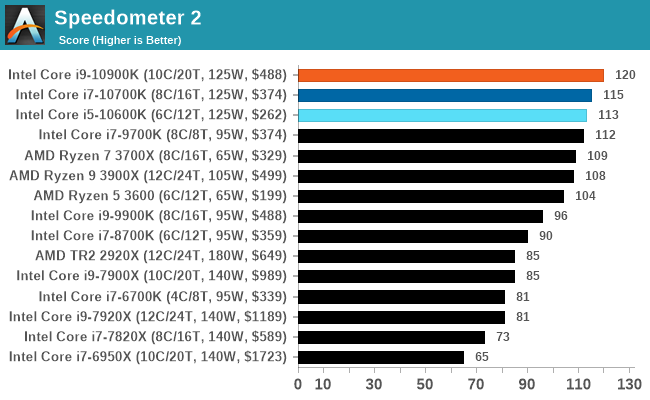
Google Octane 2.0: Core Web Compute
A popular web test for several years, but now no longer being updated, is Octane, developed by Google. Version 2.0 of the test performs the best part of two-dozen compute related tasks, such as regular expressions, cryptography, ray tracing, emulation, and Navier-Stokes physics calculations.
The test gives each sub-test a score and produces a geometric mean of the set as a final result. We run the full benchmark four times, and average the final results.
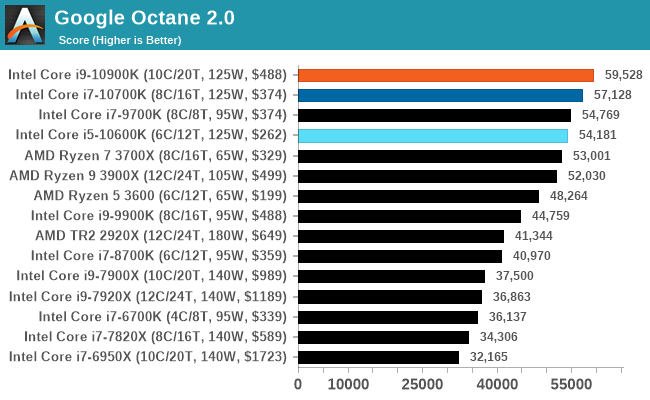
Mozilla Kraken 1.1: Core Web Compute
Even older than Octane is Kraken, this time developed by Mozilla. This is an older test that does similar computational mechanics, such as audio processing or image filtering. Kraken seems to produce a highly variable result depending on the browser version, as it is a test that is keenly optimized for.
The main benchmark runs through each of the sub-tests ten times and produces an average time to completion for each loop, given in milliseconds. We run the full benchmark four times and take an average of the time taken.
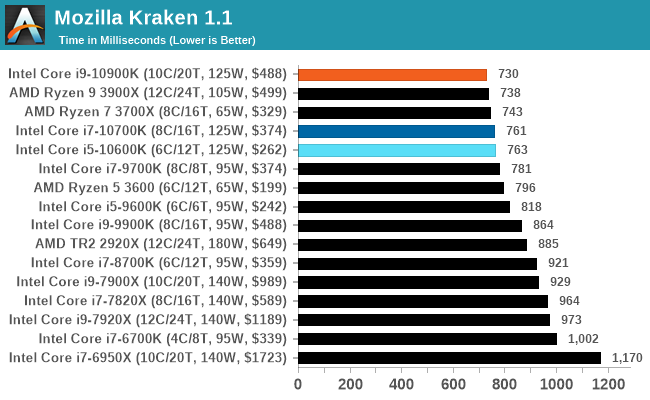
3DPM v1: Naïve Code Variant of 3DPM v2.1
The first legacy test in the suite is the first version of our 3DPM benchmark. This is the ultimate naïve version of the code, as if it was written by scientist with no knowledge of how computer hardware, compilers, or optimization works (which in fact, it was at the start). This represents a large body of scientific simulation out in the wild, where getting the answer is more important than it being fast (getting a result in 4 days is acceptable if it’s correct, rather than sending someone away for a year to learn to code and getting the result in 5 minutes).
In this version, the only real optimization was in the compiler flags (-O2, -fp:fast), compiling it in release mode, and enabling OpenMP in the main compute loops. The loops were not configured for function size, and one of the key slowdowns is false sharing in the cache. It also has long dependency chains based on the random number generation, which leads to relatively poor performance on specific compute microarchitectures.
3DPM v1 can be downloaded with our 3DPM v2 code here: 3DPMv2.1.rar (13.0 MB)
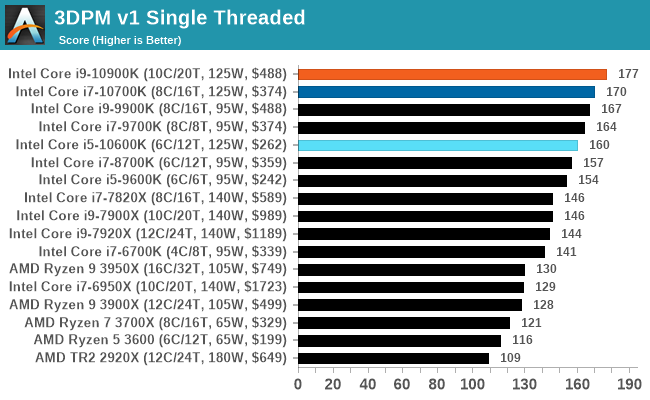
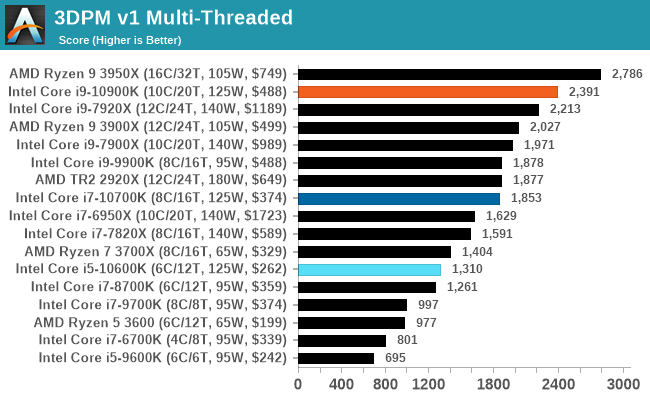
x264 HD 3.0: Older Transcode Test
This transcoding test is super old, and was used by Anand back in the day of Pentium 4 and Athlon II processors. Here a standardized 720p video is transcoded with a two-pass conversion, with the benchmark showing the frames-per-second of each pass. This benchmark is single-threaded, and between some micro-architectures we seem to actually hit an instructions-per-clock wall.
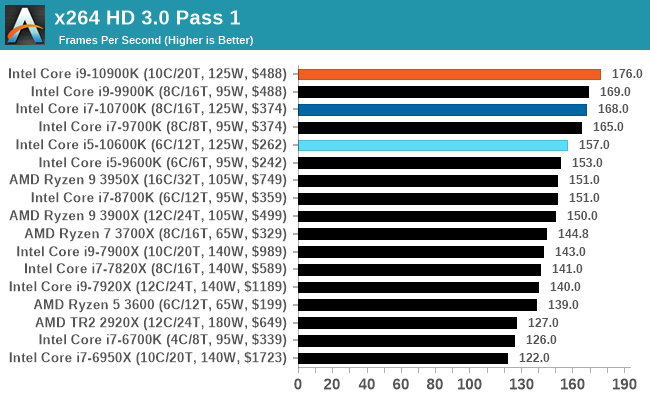
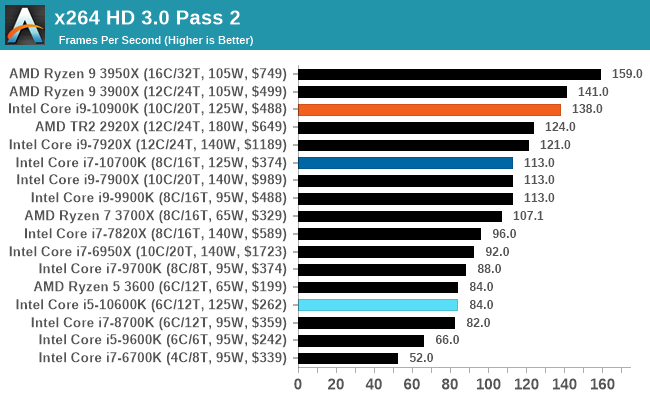










220 Comments
View All Comments
catavalon21 - Wednesday, May 20, 2020 - link
+1Lord of the Bored - Friday, May 22, 2020 - link
The nostalgia is strong these days.Bidz - Wednesday, May 20, 2020 - link
So... where is the temperature chart? Given the power usage and the tier level of the product I would say many users want to know how practical it is to use.LawRecords - Wednesday, May 20, 2020 - link
Agreed. Its odd that thermals are missing given the high power draw.shabby - Wednesday, May 20, 2020 - link
I'd imagine it would be pegged at 90c since the cpu is constantly clocking itself as high as it can.DannyH246 - Wednesday, May 20, 2020 - link
Its not odd at at all. Its to make Intel look better we all know this.shady28 - Wednesday, May 20, 2020 - link
LTT has a video on thermals. The thermals for the gen 10 are better than gen 9, despite the higher clocks and core counts. Intel redesigned the conductive layer between the die and the lid. It worked.Spunjji - Tuesday, May 26, 2020 - link
Seriously? The thermals are better despite the higher power draw?I'm guessing this is a case of being able to get the heat out more easily *if you have a cooling system capable of subsequently dealing with the heat being pulled out*. That would make sense given the changes involved, but it involves the assumption that people are prepared to go from 280mm+ radiators.
mrvco - Wednesday, May 20, 2020 - link
I get that this is a CPU review and not a GPU or system review, but it would be helpful to also include gaming resolutions w/ quality settings that people actually use for gaming rather just benchmarking... especially when building a gaming system and making decisions on how to allocate budget between CPU (+p/s +cooling) and GPU.TheUnhandledException - Wednesday, May 20, 2020 - link
I agree. Yes the result will show nearly identical performance from a 10900 down to an Ryzen 3600 but that is kinda the point. You don't really need an ultra high end CPU for gaming at high resolution. Even if it was just one game it would be nice to see how CPU performance scales at 1080p, 1080p high quality, 1440p, and 4K.